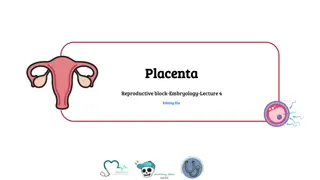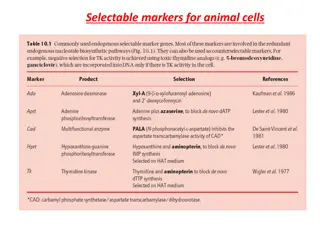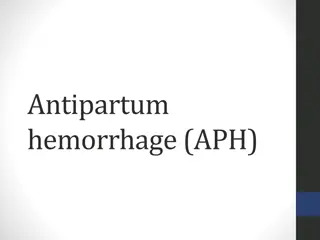
Placenta Abruption: Causes, Types, and Clinical Presentation
Bleeding at the decidual-palacental interface causing placental detachment, with risks, incidence, and fetal outcomes. Learn about types, risk factors, clinical signs, and management of placenta abruption.
Download Presentation

Please find below an Image/Link to download the presentation.
The content on the website is provided AS IS for your information and personal use only. It may not be sold, licensed, or shared on other websites without obtaining consent from the author. If you encounter any issues during the download, it is possible that the publisher has removed the file from their server.
You are allowed to download the files provided on this website for personal or commercial use, subject to the condition that they are used lawfully. All files are the property of their respective owners.
The content on the website is provided AS IS for your information and personal use only. It may not be sold, licensed, or shared on other websites without obtaining consent from the author.
E N D
Presentation Transcript
*Placenta Abruption (abruptio placentae)
*Definition: bleeding at the decidual-palacental interface that causes partial or total placental detachment prior to delivery of the fetus over 24 weeks of gestation *Types: Concealed and revealed hemorrhage .
Incidence: 0.4%-1% of pregnancies 40-70% occurs before 37 weeks . Severe abruption can kill fetus 1 in 1600 births. It is a significant cause of maternal morbidity and perinatal morbidity and mortality (Pnmortality :12% and 77% occurs in utero ) PNm Rate : the number of stillbirths and deaths in the first week of life per 1000 live birth.
* Risk factors: 1-Abdominal trauma / accidents 2-cocain or other drug abuse( hypertension,vasoconstriction of placental b.v) 3-Poly hydramnios 4-hypertensive disease during pregnancy (3-4 fold increase) 5-premature rupture of membranes , incidence: 5% 6-chorioamnionitis , I uGR 7- previous abruptio: recurrence 5-15% Third rises the incidence 20-25% 8- with increasing age, parity and moking 9-uterine anomalies , leiomyoma, uterine synchiae 10-first trimester bleeding 11-thrombophilia :inherited factor V Leiden Acquired : APL.syndrome
*Clinical presentation: -vaginal bleeding (mild,moderate or severe) -Abdominal pain or back pain ( if posterior placenta) -DIC occurs in 10-20% of severe abruption and death of fetus(severe if placenta separate >50%) - B.P ,FH abnormalities or death - Tender or rigid or firm abdomen (woody feel) - Hypertonic uterine contractions - DIC - Hypovolemic shock , renal failure , ARDS multiorgan failure - Hysterectomy, blood transfusion,rarely death - Couvelaire uterus
*Fetal & neonatal outcome: Increased mortality and morbidity due asphyxia , IUGR, hypoxemia, and preterm delivery. -Recurrence: Several fold higher risk of abruption in subsequent pregnancy= 5-15% Risk of third rises 20-25% Management: depends on condition of the mother , fetus and gestational age . Chronic abruption: light, chronic, intermittent bleeding , oligohydroamnious , IUGR, pre-ecclampsia , preterm ro.m Coag.studies usually normal .
*Placenta previa *Definition: the presence of placental tissue that extends over or lies proximate to the internal cervical os. (beyond 24 weeks of gestation ) *Degrees: 1-total or complete placenta previa: the placenta completely covers the internal os 2-partial previa : the placenta partially covers the I.O 3-marginal previa : the edge of the placenta extends to the margin of the I.O 4-low-lying placenta : placental margin is within 2cm of I.O
*Presentation: -painless , recurrent vaginal bleeding in 70-80% -uterine contractions in 10-20% Prevalence : 3.5-4.6/1000 births Recurrence : 4-8% Risk factors: -previous c/s, placenta previa -multiple gestation, multiparity , advanced maternal age. -infertility treatment , previous abortion -previous intrauterine surgical procedures -maternal smoking , cocaine use -non white race , male fetus
*Associated conditions : Placenta accreta : complicated 1-5% patients with placenta previa . If previous c/s : 11-25% Two c/s : 35-47% Three c/s : 40% Four c/s : 50-67% Preterm labor , rupture of membrane , mal presentation ,IUGR, vasa previa , congenital anomalies , amniotic fluid embolism .
*Diagnosis : Soft abdomen , normal fetal heart , mal presentation -avoid vaginal ,rectal examination or sexual intercourse Investigation: 1-abdominal u/s : false +ve 25% due to over distended bladder or uterine contractions , or can be missed if fetal head is low in pelvis 2-transvaginal u/s : (if diagnosis by abdominal u/s not certain) , or trans perineal u/s 3-MRI : High cost
*Management : Treatment depends on gestational age , amount of vaginal bleeding , maternal status and fetal condition . Expectant management : If fetus is preterm less than 37 weeks : -hospitalization -investigations ( cbc , rft , lft , coagulation factors , blood grouping and rh ) -Steroids (between 24-34 weeks ) -antiD ig if the mother is rh negative -cross match blood and blood products . -CTG -elective c/s : if fetus more than 37 weeks -emergency c/s : if severe bleeding or fetal distress
*Morbidity and mortality : -hemorrhage -hypovolemic shock (renal.f , shehan s syndrome, death) -blood transfusion risk -hysterectomy , uterine/iliac A ligation or embolization of pelvic vessels -Increase mmR -Increase neonatal morbidity .
*Vasa previa : 1:2000 -fetal BV cross or run near the cervix. -rare but very serious cause of vaginal bleeding -bleeding is fetal in origin associated with velamentous cord insertion where fetal blood vessels in the membranes cross the cervix . Rupture of membranes can lead to tearing of fetal B.V with exsanguination of the fetus . Tests are often not applicable . Normal placenta Diagnosis by color flow doppler ultrasound Risk factors: -velamentous insertion: not every pregnancy with velamentous insertion results in vasa previa, only when BV near the cervix. -Bi-lobed or succenturiate lobed placenta -multiple pregnancy -low lying placenta -IVF pregnancy






















